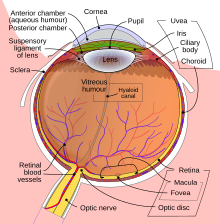User:Mr. Ibrahem/Posterior vitreous detachment
| Posterior vitreous detachment | |
|---|---|
| Other names | Vitreous detachment |
 | |
| Schematic diagram of the human eye. | |
| Specialty | Opthalmology |
| Symptoms | Floaters, flashes of light[1] |
| Complications | Retinal tear, retinal detachment, macular hole, macular pucker[1] |
| Usual onset | >50 yr old[1] |
| Risk factors | Nearsightedness[1] |
| Diagnostic method | Dilated eye exam[1] |
| Differential diagnosis | Migraine aura, uveitis, retinitis pigmentosa[2] |
| Treatment | None, surgery[1] |
| Prognosis | Usually good[2] |
| Frequency | Common[1] |
Posterior vitreous detachment (PVD) is a condition of the eye in which the vitreous separates from the retina.[3][4] Symptoms include floaters and flashes of light in the peripheral vision.[1] Pain does not occur.[3] This generally resolves over a few months.[1] Complications may include retinal tear, retinal detachment, macular hole, macular pucker, and vitreous bleed.[1][2]
Risk factors include being nearsighted.[1] Episodes may be triggered by cataract surgery, trauma, uveitis, and laser capsulotomy.[2] The underlying mechanism involves age related softening of the vitreous.[3] Diagnosis is by dilated eye exam.[1] Other measures used may include ultrasound and optical coherence tomography.[2]
In most cases no specific treatment is required.[1] Follow up may be recommended in 2 to 4 weeks to rule out complications.[2] Outcomes are usually good.[2] If the condition causes significant problems surgery, known as a vitrectomy, may be tried.[1]
Posterior vitreous detachment becomes common as people age.[1] About half of people over the age of 50 are affected.[2] Women are more commonly affected at a younger age.[2] It was first described in 1856 by Muller and 1875 by Briere.[2]
References[edit]
- ^ a b c d e f g h i j k l m n o "Vitreous Detachment | National Eye Institute". www.nei.nih.gov. Archived from the original on 10 February 2022. Retrieved 11 February 2022.
- ^ a b c d e f g h i j Ahmed, Faryal; Tripathy, Koushik (2022). "Posterior Vitreous Detachment". StatPearls. StatPearls Publishing. Archived from the original on 22 January 2022. Retrieved 11 February 2022.
- ^ a b c Gauger E; Chin EK; Sohn EH (17 November 2014). "Vitreous Syneresis: An Impending Posterior Vitreous Detachment (PVD)". University of Iowa Health Care: Ophthalmology and Visual Sciences. Archived from the original on 5 July 2020. Retrieved 7 June 2021; See "Discussion" following "Clinical Course".
{{cite web}}: CS1 maint: postscript (link) - ^ "Posterior vitreous detachment". RNIB - See differently. 19 February 2014. Archived from the original on 29 June 2021. Retrieved 11 February 2022.
